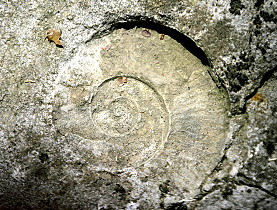Death came from the deep for early life

One of the first cases of massive extinction was due to a change in the chemical composition of the planet's oceans, according to Swiss researchers.
Ediacara, the dominant lifeform around 540 million years ago, was wiped out and later replaced by new species during what is known as the Cambrian explosion.
Ediacara are the earliest known complex multicellular organisms. They appeared around 600 million years ago as the Earth emerged from a period of freezing, but their fossil record ends almost abruptly.
“It was not clear what happened at this Pre-Cambrian/Cambrian boundary,” said Thomas Nägler, a geology professor at Bern University. “A lot of new species emerged later, many with skeletons that were not seen before then.”
To find out, Nägler and his colleagues measured the amount and types of molybdenum isotopes found in black shale samples from China and Oman.
“Isotopes are like fingerprints,” the geologist told swissinfo. “They help explain what no longer exists.”
So what happened? According to Nägler, the disappearance of one of the earliest life forms can be explained by a so-called ocean overturn.
At the time, the Earth’s oceans were structured in layers, with molybdenum isotopes more present in the upper zones. Deeper down, hydrogen sulphide (H2S) could be found.
For a reason yet to be determined, ocean circulation changed, pushing the H2S towards less shallow zones, where it reacted with isotopes of the naturally occurring trace metal. The reaction produced compounds that eventually sunk into the bottom sediment and can be found in shale samples today.
“To produce the signature of molybdenum isotopes we see today, there had to be an upswelling of H2S. It is the only chemical that could have produced in large quantities such a result,” added Nägler.
Analysis of the shale samples showed that there was a disturbance, and further computer modelling confirmed that particular conditions were necessary to produce it. H2S is also toxic at low concentrations for almost all living creatures.
Unknown cause
Nägler is convinced the results, which are published in the latest edition of science journal Nature, have solved some of the mystery surrounding the disappearance of the Ediacara.
“Our data, combined with what is known about evolution at that time, is a good fit with one of the existing hypotheses,” he added.
“Our result shows us why the Edicara died out. What we need to know now is why the ocean circulation changed.”
However, as a geochemistry specialist, he admits he cannot explain this. There are however a number of possible culprits, among them continental drift.
“The continents are constantly moving and you have places for example like the Panama gateway, which closed off and changed the whole ocean circulation,” he told swissinfo.
Climate variation could have also played a role. “We know today that ocean circulation depends mainly on temperature differences. If you change the climate, you can change ocean circulation,” said Nägler.
The final suspect is the planet itself.
“We know that around that period there was significant change in the Earth’s magnetic field and the planet’s axis probably moved too. This can also affect ocean circulation,” added the geologist.
swissinfo, Scott Capper
The Ediacara represent the earliest known complex multicellular organisms. They appeared soon after the Earth emerged from the cold Cryogenian period and disappeared almost entirely just before the rapid appearance of biodiversity known as the Cambrian explosion.
The Cambrian period saw the appearance of the body-plans that would form the basis of modern animals.
The organisms of the Ediacaran Period first appeared around 580 million years ago and flourished until around 540 million years ago, according to the fossil record.
A number of hypotheses have been developed to explain this disappearance, including environmental change, the arrival of predators, and competition from other lifeforms.

In compliance with the JTI standards
More: SWI swissinfo.ch certified by the Journalism Trust Initiative










You can find an overview of ongoing debates with our journalists here . Please join us!
If you want to start a conversation about a topic raised in this article or want to report factual errors, email us at english@swissinfo.ch.